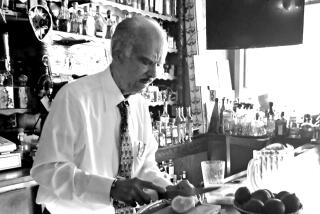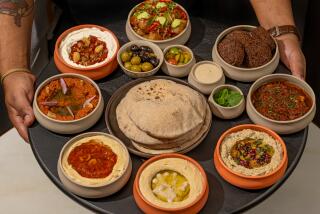Barney’s Beanery rocks on at 90

It’s a story so revolting and so legendary that it has achieved near mythical status. One night in the 1960s, during a particularly heavy bout of drinking, Jim Morrison stood up and urinated on the long wooden bar at Barney’s Beanery in West Hollywood. Rock god status and titillating snug leather pants or not, Morrison was booted from the famous restaurant and bar.
“Of course, this being Barney’s, they wiped it off and put a plaque there,” jokes Jim Ladd, the KLOS-FM DJ known for spinning raw, classic rock sans formulaic playlists for nearly 40 years. He adds, “Probably every rocker that has ever come through L.A. has gone to Barney’s.”
This month, with Barney’s celebrating its 90th birthday, Ladd’s observation speaks to Barney’s reputation as a gritty clubhouse for the famous and those who love them but leave them be. Since its opening, the cluttered wooden roadside shack has drawn the likes of Clark Gable, Rita Hayworth, Jimmy Page, Jack Nicholson, Quentin Tarantino and many more with its greasy food and rough-and-tumble atmosphere. And, due to a longstanding (now exorcised) intolerance of gays, it has generated as much controversy as it has plates of chili.
In this way, Barney’s is not so much a restaurant as it is a bawdy, off-color, sometimes exasperating but ultimately charismatic celebrity.
Barney’s Beanery, which is one of the oldest restaurants in L.A., was initially opened in Berkeley by L.A. native and World War I veteran John “Barney” Anthony. In search of a more moderate climate, Anthony moved the restaurant to its current location on Santa Monica Boulevard in 1927. At the time, the area was a dusty outpost surrounded by a poinsettia field, and the restaurant itself was not much more than a shack.
As the country sank into the hopeless, hungry muck of the Great Depression, Barney’s managed to thrive due to the prevalence and economy of its main staple: beans. That and Anthony’s well-known tendency to extend credit to the less fortunate. He even gave away plates of beans to people traveling west in search of work in exchange for their license plates. Today the license plates above the bar at Barney’s stand as reminders of that era.
And beans, it turns out, are equally lucrative in today’s Great Recession. During a time when many restaurants are closing down, David Houston, who has co-owned Barney’s since 1999, has opened up four new outposts, effectively turning the restaurant into a chain.
Houston has plans for one more Barney’s in downtown L.A. but is leery of diluting the “coolness” of the original brand by opening any more in this city.
His instinct about that is probably spot on, because as Ladd says, the reason Barney’s has managed to capture the allegiance of noteworthy Angelenos from one decade to the next is because “it hasn’t changed much over the years. It’s authentic, very authentic. And despite being world-famous it’s not a tourist trap, and that’s certainly not typical.”
But before it was widely known — thanks in large part to Morrison’s exploits and the fact that Janis Joplin is said to have eaten her last meal there before overdosing at the Landmark Motor Hotel — Barney’s was simply cheap.
“When I first started going there, the kitchen of the restaurant was a dirt floor,” says artist Billy Al Bengston, who was part of La Cienega’s legendary Ferus Gallery in the late 1950s and early 1960s. Ferus artists including Robert Irwin, Larry Bell and Ed Kienholz used to hang out there because, Bengston says, it was the only bar in the area at the time and Anthony extended them credit. In fact, Bengston says he and artist Dane Dixon started a joint tab that he believes never got paid off.
“The best thing they had in the house was a steak sandwich, and one night I ordered five steak sandwiches and didn’t get to eat any of them because Kienholz took them away from me before they got to me,” remembers Bengston, who also recalls meeting both Howard Hughes and Nicholson at Barney’s.
“There was an interesting mix of people there at that time. Rita Hayworth was there when [the artists] were hanging out, but she made it clear that she wanted to be left alone,” says writer and filmmaker Kristine McKenna, whose book, “The Ferus Gallery: A Place to Begin,” devotes space to Barney’s. McKenna also co-wrote the documentary “The Cool School,” which quotes Ken Price as saying that if there had been a flash grease fire at Barney’s around 1960, the entire L.A. art scene would have been destroyed.
As a drug-addled hippie sun rose on the ‘60s, the Sunset Strip — and with it the stretch of La Cienega that housed Ferus and was just around the corner from Barney’s — became one of the main epicenters of the new cultural divide.
“Everything started going more upscale, and the artists started doing so well that they didn’t need to eat at Barney’s anymore,” McKenna says.
Not long after that, Barney’s became known as a rock ‘n’ roll roadhouse — a reputation that remains with it to this day.
“It reflected the feelings people had about freedom and society and our culture at the time,” says Jeff Jampol, manager of the Doors and the Joplin estate. “If you wanted to hang out, you knew that the only other place that had that kind of cultural weight and import at that time was the Troubadour.”
This period strikes many a modern mind as odd. Because while the counterculture revolution was happening inside the ragged restaurant with its scratched wooden tables, garish multicolored booths, filthy pool tables, newspaper menus and aged black-and-white photos, the restaurant’s owner was openly discriminating against gays.
In the 1940s, Anthony had put up a sign that read “Fagots Stay Out” (sic). The sign remained under the ownership of Irwin Held, who bought the bar when Anthony died in 1968. In West Hollywood, which had long attracted a gay community, the sign was unforgivably offensive.
“We started picketing the restaurant in 1970, and on March 12, he said he would take the sign down, but then he put up more signs and had matchbooks [with those words on it] made,” remembers Rev. Troy Perry, who lived in West Hollywood and founded the gay-friendly Metropolitan Community Church in 1968.
When West Hollywood was incorporated as a city in November of 1984, one of the first things the new government did was pass an anti-discrimination ordinance. The popular story goes that “they actually adjourned the meeting and walked down to Barney’s and took the sign down,” says John J. Duran, mayor pro tem of West Hollywood. “And it was handed to Valerie Terrigno, the first mayor of West Hollywood.” Terrigno was one of the first lesbian mayors of an incorporated municipality in the U.S.
In reality, the city had to threaten Held with a $500-a-day fine before he reluctantly agreed to let Terrigno and another council member remove the sign in January 1985.
“I think in some ways, Barney’s inspired the city of West Hollywood to form because they wanted to get that sign down,” says current co-owner Houston, who in 2005 invited Perry to Barney’s to offer a public apology for the restaurant’s legacy.
“I went in and it was so cute, I even had their world-famous chili,” Perry says. “It was an amazing story as he and I sat there and talked about how it was a new day for Barney’s Beanery.”
Today, in keeping with its nearly centenarian status, the restaurant continues to generate new stories. This year, it experienced a fresh burst of national interest when, during the NBA play-offs, talk show host Jimmy Kimmel invited a longtime Barney’s busboy, Ricardo Reyes, to compete in Pop-a-Shot competitions with NBA stars including LeBron James, Kobe Bryant and Carmelo Anthony, all of whom Reyes beat handily. (Pop-a-Shots are mini-basketball game machines like the ones at Barney’s.)
“It transcends just funny, it’s a real-life ‘Rocky’ kind of thing — this little guy who’s a busboy defeating some of the best players in the world,” says Will Burke, the “Jimmy Kimmel Live” writer who came up with the idea after a friend and Barney’s regular tipped him off to Reyes’ skills. “I think it would have been a lot lamer if Ricardo had been a busboy at Hooters or some lame chain like that, but Barney’s is such an important part of L.A. culture.”
More to Read
Eat your way across L.A.
Get our weekly Tasting Notes newsletter for reviews, news and more.
You may occasionally receive promotional content from the Los Angeles Times.







